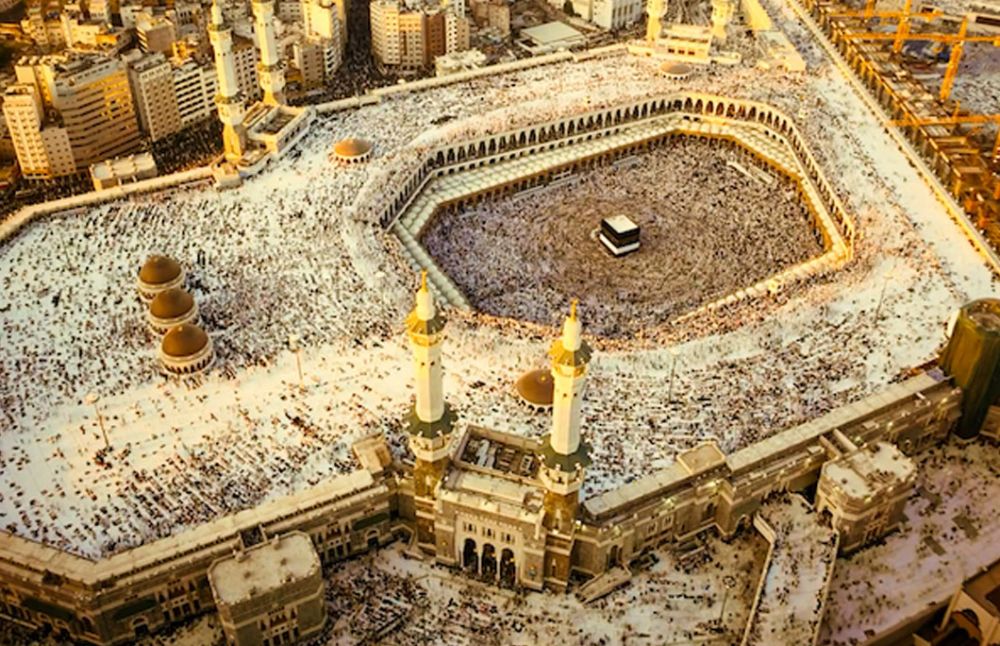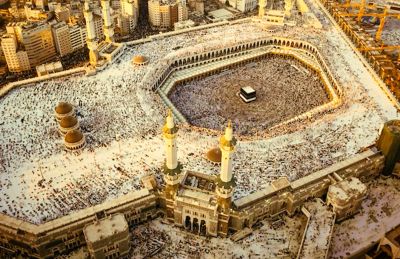

The Grand Mosque, known as Masjid al-Haram, is the holiest site in Islam and the focal point of the Islamic Pilgrimage, the Hajj. It's the largest mosque in the world and surrounds the Kaaba, which Muslims face during their daily prayers. Visitors and worshippers can experience the majestic Ottoman and Abbasid architecture, immerse themselves in the spiritual atmosphere, and join in prayer. The mosque is also home to the Zamzam Well, and pilgrims often drink its water, believing in its healing properties. While non-Muslim visitors cannot enter the mosque, they can admire its grandeur from the outside and learn about its significance in Islamic tradition. The experience at Masjid al-Haram can be profound and is a must for any visitor to Makkah capable of entering the mosque.
Jabal al-Nour, or the Mountain of Light, is a significant landmark situated near Mecca. It is renowned for housing the Hira cave, where Prophet Muhammad received his first revelation from the angel Gabriel. Climbing Jabal al-Nour offers not only a spiritual experience but also a moderate physical challenge. The trek to the top usually takes about 1.5 to 2 hours, and visitors are treated to panoramic views of the surrounding mountains and the city of Mecca. Though the climb is free, it requires a good level of fitness and sturdy shoes. Pilgrims and tourists alike engage in this climb as a form of reflection and connection with their faith.
The Makkah Museum, also known as the Al-Zaher Palace Museum, offers a comprehensive glimpse into the rich history of Islam and the city of Makkah. It is housed in a restored palace and features a collection of artifacts, manuscripts, and exhibits that trace the history of Islam and the evolution of the Grand Mosque. Visitors can spend a couple of hours delving into Islamic culture, the heritage of the region, and the advancements made in Islamic sciences. The museum presents an educational experience for both Muslims and non-Muslim visitors interested in the origins and development of one of the world's major religions.
Located inside one of the tallest buildings in the world, the Abraj Al Bait Towers, the Makkah Clock Tower Museum offers an opportunity to explore the universe's wonders through an Islamic lens. It features astronomical displays and scientific marvels, including a lunar gallery, and offers insight into the history of timekeeping in Islam. The museum highlights the architectural features of the Clock Tower itself, and visitors can enjoy a panoramic view of Makkah from the observation decks. The museum provides a unique fusion of science, history, and spirituality, making it an educational and enjoyable experience for visitors of all ages.
Masjid al-Rahmah, known as the floating mosque, is situated on the Red Sea and presents an astounding architectural marvel. It provides a tranquil environment for prayer and contemplation, away from the bustling city center. Visitors, especially Muslims, come here to offer prayer and to sit by the Red Sea, feeling the cool breeze and listening to the calming sound of waves. Attending a prayer session here provides a peaceful break from the usual hectic pilgrim activities and a chance for introspection and spiritual rejuvenation. The mosque gets its name from its location over the water, giving it the appearance of floating during high tide.
Jabal Thawr is a mountain in the lower part of Makkah and is known for the cave where Prophet Muhammad and his companion Abu Bakr hid from their persecutors during the migration to Medina. The climb to the cave is quite steep and may take around 2 hours. Once at the top, visitors are rewarded with a sense of historical significance and breathtaking views of the surrounding landscape. The cave itself provides a humble reminder of the early struggles of Islam. A visit to Jabal Thawr offers both a physical and spiritual reflection opportunity for believers and an interesting historical site for non-Muslim visitors.
Makkah Mall is one of the largest shopping centers in the city, providing a modern, air-conditioned environment for a diverse shopping experience. Visitors can find a mix of local and international brands offering clothing, electronics, and souvenirs. The mall also has a variety of dining options, from fast food to traditional Middle Eastern cuisine. Furthermore, it houses a supermarket for everyday necessities. Families may appreciate the entertainment options, including a play area for children. Makkah Mall is an excellent place for pilgrims and tourists to take a break from spiritual activities and enjoy some leisure time.
Performing Ziyarat in Makkah is an important activity for many Muslims visiting the city. Ziyarat involves visiting historical and religious sites such as the birthplace of Prophet Muhammad, the Jannat al-Mu'alla cemetery, where the Prophet's ancestors are buried, and other significant locations like the sites of the Battle of Trench and the Treaty of Hudaybiyyah. These tours provide visitors with a deeper understanding of Islamic history and the life of the Prophet Muhammad. While access to some sites may depend on local regulations and religious observances, there is often no cost to visit them, and they offer invaluable insights for those interested in religious history.
Souk Al-Khalil is one of the traditional markets where visitors can immerse themselves in the bustling atmosphere of a Middle Eastern bazaar. Here, one can find a myriad of items ranging from perfumes, textiles, and gold to local handicrafts and delicious street food. Bargaining is common, so shoppers have the chance to engage with local vendors and potentially secure good deals. It's an authentic cultural experience that allows visitors to get a sense of daily life in Makkah while purchasing unique souvenirs and gifts for loved ones back home.
The Al Wahbah crater, located a few hours away from Makkah, is a natural wonder that offers an escape from the spiritual and urban activities in the city. This volcanic crater, approximately 2 kilometers in diameter, has been a source of scientific interest and is thought to have been formed by an underground steam explosion. The bottom of the crater is covered with white sodium phosphate crystals, giving it a striking appearance. Visitors can hike to the bottom or around the rim, enjoying the stark but beautiful landscape. A trip to Al Wahbah crater provides a great opportunity to explore the geological diversity of Saudi Arabia.
